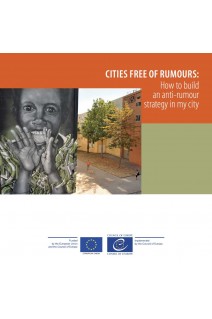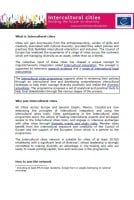



Have you ever heard people saying things like: “Migrants live of social benefits”, “Migrants don’t pay taxes”, “Migrants get favourable treatment from official bodies”, “Migrants overcrowd medical services”, “Migrants lower educational standards” or “Migrants are not willing to integrate”? Such ideas are generally not backed up by facts and data – they are rumours. Rumours target specific groups as “problematic” and generate mistrust and social conflict, including discrimination, racism and xenophobia.
The Communication for Integration (C4i) project of the Council of Europe and the European Union has engaged 11 European cities to counter widespread urban myths about diversity using viral communication campaigns and participatory initiatives.
This guide is designed for city leaders and policy makers wishing to learn how to build, implement and monitor anti-rumour strategies in their cities. It offers innovative responses to real-life challenges related to international migration and illustrates them with suggestions and practical examples from European cities. The guide relies on the understanding, which is at the core of the Council of Europe’s Intercultural Cities programme, that diversity can be an asset to the social, cultural and economic development of urban settings, if managed positively.
Contents
ACKNOWLEDGEMENTS
PREFACE
WHY AN ANTI-RUMOUR STRATEGY?
A global challenge and the role of cities
The Intercultural Cities framework
The origin and evolution of the anti-rumour strategy
The C4i project and the purpose of this guide
THE KEY ELEMENTS OF AN ANTI-RUMOUR STRATEGY
Political commitment, consensus and mainstreaming
Engaging and participating: this is a “city” strategy
Seducing more than blaming: the main target is the “ambivalent” majority
Creativity at all levels: the real essence of the strategy’s core identity
Rigour, results and sustainability: much more than spreading anti-rumour data
A STEP-BY-STEP ANTI-RUMOUR STRATEGY
Preparation
Identifcation and analysis of the main rumours
Collecting anti-rumour data and arguments
Building an anti-rumour social network
Training anti-rumour agents
Design and implementation of anti-rumour campaigns
EVOLUTION AND SUSTAINABILITY
An in-depth analysis of the evaluation and impact
Internal support
External engagement and commitment
Being part of a global and innovative strategy
What next?
APPENDIX I – BEST PRACTICE CASE STUDIES
APPENDIX II – CORE INDICATORS FOR IMPACT AND CHANGE EVALUATION
APPENDIX III – THEORY OF CHANGE MAP
APPENDIX IV – WEBSITES


Have you ever heard people saying things like: “Migrants live of social benefits”, “Migrants don’t pay taxes”, “Migrants get favourable treatment from official bodies”, “Migrants overcrowd medical services”, “Migrants lower educational standards” or “Migrants are not willing to integrate”? Such ideas are generally not backed up by facts and data – they are rumours. Rumours target specific groups as “problematic” and generate mistrust and social conflict, including discrimination, racism and xenophobia.
The Communication for Integration (C4i) project of the Council of Europe and the European Union has engaged 11 European cities to counter widespread urban myths about diversity using viral communication campaigns and participatory initiatives.
This guide is designed for city leaders and policy makers wishing to learn how to build, implement and monitor anti-rumour strategies in their cities. It offers innovative responses to real-life challenges related to international migration and illustrates them with suggestions and practical examples from European cities. The guide relies on the understanding, which is at the core of the Council of Europe’s Intercultural Cities programme, that diversity can be an asset to the social, cultural and economic development of urban settings, if managed positively.
